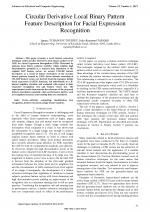| 1/2019 - 7 |
Circular Derivative Local Binary Pattern Feature Description for Facial Expression RecognitionTCHANGOU TOUDJEU, I. |
| Extra paper information in |
| Click to see author's profile in |
| Download PDF |
Author keywords
affective computing, classification, face recognition, feature extraction, image texture analysis
References keywords
facial(19), recognition(18), local(13), binary(11), patterns(8), pattern(8), image(6), classification(6), icme(4), comput(4)
Blue keywords are present in both the references section and the paper title.
About this article
Date of Publication: 2019-02-28
Volume 19, Issue 1, Year 2019, On page(s): 51 - 56
ISSN: 1582-7445, e-ISSN: 1844-7600
Digital Object Identifier: 10.4316/AECE.2019.01007
Web of Science Accession Number: 000459986900007
SCOPUS ID: 85064192591
Abstract
This paper presents a novel feature extraction technique called circular derivative local binary pattern (CD-LBP) for Facial Expression Recognition (FER). Motivated by uniform local binary patterns (uLBPs) which exhibits high discriminative potential at a reduced data dimension of the original LBP feature vector, we extract CD-LBP feature descriptors as a result of binary derivatives of the circular binary patterns formed by LBPs. Seven datasets consisting of CD-LBP feature vectors are derived from the Japanese female facial expression (JAFFE) database, fed individually in a K-nearest neighbor classifier and evaluated with respect to their respective recognition rate and feature vector size. The experimental results demonstrate the relevance of the proposed feature description especially when performance metrics such as recognition accuracy and running time are considered. |
| References | | | Cited By |
Web of Science® Times Cited: 3 [View]
View record in Web of Science® [View]
View Related Records® [View]
Updated 2 weeks, 5 days ago
SCOPUS® Times Cited: 6
View record in SCOPUS® [Free preview]
View citations in SCOPUS® [Free preview]
[1] Developing a machine learning-based approach for predicting road surface friction using dash camera images—a City of Edmonton, Canada, case study, Xie, Qian, Kwon, Tae J., Canadian Journal of Civil Engineering, ISSN 0315-1468, Issue 10, Volume 50, 2023.
Digital Object Identifier: 10.1139/cjce-2023-0015 [CrossRef]
[2] Modified feature extraction techniques to enhance face and expression recognition, Shrestha, Kshitiz, Alsadoon, Abeer, Al-Naymat, Ghazi, Jerew, Oday D., Multimedia Tools and Applications, ISSN 1573-7721, 2024.
Digital Object Identifier: 10.1007/s11042-024-20157-3 [CrossRef]
[3] MRI Brain Classification Using the Quantum Entropy LBP and Deep-Learning-Based Features, Hasan, Ali M., Jalab, Hamid A., Ibrahim, Rabha W., Meziane, Farid, AL-Shamasneh, Ala’a R., Obaiys, Suzan J., Entropy, ISSN 1099-4300, Issue 9, Volume 22, 2020.
Digital Object Identifier: 10.3390/e22091033 [CrossRef]
[4] LBPMobileNet-based novel and simple leather image classification method, Varghese, Anjli, Jawahar, Malathy, Prince, A. Amalin, Gandomi, Amir H., Neural Computing and Applications, ISSN 0941-0643, 2025.
Digital Object Identifier: 10.1007/s00521-024-10745-7 [CrossRef]
[5] Texture Analysis on Digital Microscopic Leather Images For Species Identification, Varghese, Anjli, Jawahar, Malathy, Prince, A Amalin, Gandomi, Amir H, 2022 9th International Conference on Soft Computing & Machine Intelligence (ISCMI), ISBN 979-8-3503-2088-6, 2022.
Digital Object Identifier: 10.1109/ISCMI56532.2022.10068472 [CrossRef]
Disclaimer: All information displayed above was retrieved by using remote connections to respective databases. For the best user experience, we update all data by using background processes, and use caches in order to reduce the load on the servers we retrieve the information from. As we have no control on the availability of the database servers and sometimes the Internet connectivity may be affected, we do not guarantee the information is correct or complete. For the most accurate data, please always consult the database sites directly. Some external links require authentication or an institutional subscription.
Web of Science® is a registered trademark of Clarivate Analytics, Scopus® is a registered trademark of Elsevier B.V., other product names, company names, brand names, trademarks and logos are the property of their respective owners.
Faculty of Electrical Engineering and Computer Science
Stefan cel Mare University of Suceava, Romania
All rights reserved: Advances in Electrical and Computer Engineering is a registered trademark of the Stefan cel Mare University of Suceava. No part of this publication may be reproduced, stored in a retrieval system, photocopied, recorded or archived, without the written permission from the Editor. When authors submit their papers for publication, they agree that the copyright for their article be transferred to the Faculty of Electrical Engineering and Computer Science, Stefan cel Mare University of Suceava, Romania, if and only if the articles are accepted for publication. The copyright covers the exclusive rights to reproduce and distribute the article, including reprints and translations.
Permission for other use: The copyright owner's consent does not extend to copying for general distribution, for promotion, for creating new works, or for resale. Specific written permission must be obtained from the Editor for such copying. Direct linking to files hosted on this website is strictly prohibited.
Disclaimer: Whilst every effort is made by the publishers and editorial board to see that no inaccurate or misleading data, opinions or statements appear in this journal, they wish to make it clear that all information and opinions formulated in the articles, as well as linguistic accuracy, are the sole responsibility of the author.



